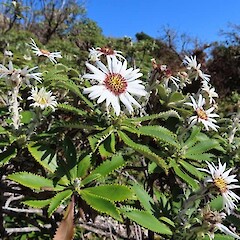Macrolearia oporina
Synonyms
Arnica oporina G.Forst., Olearia oporina (G.Forst.) Hook.f., Olearia oporina var. robusta Kirk
Family
Asteraceae
Flora category
Vascular – Native
Endemic taxon
Yes
Endemic genus
Yes
Structural class
Trees & Shrubs - Dicotyledons
NVS code
The National Vegetation Survey (NVS) Databank is a physical archive and electronic databank containing records of over 94,000 vegetation survey plots - including data from over 19,000 permanent plots. NVS maintains a standard set of species code abbreviations that correspond to standard scientific plant names from the Ngä Tipu o Aotearoa - New Zealand Plants database.
OLEOPO
Current conservation status
The conservation status of all known New Zealand vascular plant taxa at the rank of species and below were reassessed in 2017 using the New Zealand Threat Classification System (NZTCS) – more information about this can be found on the NZTCS website. This report includes a statistical summary and brief notes on changes since 2012 and replaces all previous NZTCS lists for vascular plants.
Please note, threat classifications are often suggested by authors when publications fall between NZTCS assessment periods – an interim threat classification status has not been assessed by the NZTCS panel.
- Conservation status of New Zealand indigenous vascular plants, 2017 . 2018. Peter J. de Lange, Jeremy R. Rolfe, John W. Barkla, Shannel P. Courtney, Paul D. Champion, Leon R. Perrie, Sarah M. Beadel, Kerry A. Ford, Ilse Breitwieser, Ines Schönberger, Rowan Hindmarsh-Walls, Peter B. Heenan and Kate Ladley. Department of Conservation. Source: NZTCS and licensed by DOC for reuse under the Creative Commons Attribution 4.0 International licence.
2017 | At Risk – Naturally Uncommon | Qualifiers: RR
Previous conservation statuses
2012 | At Risk – Naturally Uncommon | Qualifiers: DP, RR
2009 | Not Threatened
2004 | Not Threatened
Brief description
Small tree with narrow leathery saw-edged dark green leaves that are white underneath and large yellow-centred whiteish daisy-like heads inhabiting the Fiordland coast. Leaves 5–10 cm long by 1.5–2 cm wide, widest at middle, with large thick teeth along edge. Flowers 3–4 cm wide, petals white, centre yellow.
Distribution
Endemic. New Zealand: South Island (west and south Fiordland from Martins Bay southwards), Stewart Island/Rakiura and some surrounding islands and islets (e.g., Codfish Island / Whenua Hou).
Habitat
Coastal. Usually a component of coastal scrub or forest, often on peaty ground, where it is usually associated with muttonbird daisy (Brachyglottis rotundifolia), inaka (Dracophyllum longifolium), and kokomuka (Veronica elliptica).
Flower colours
White, Yellow
Etymology
oporina: Autumnal
Taxonomic Notes
Macrolearia oporina is closely allied to M. angustifolia and M. chathamica, and, on the assumption that all three species were allopatic, some botanists have considered them all varieties / subspecies of each other. This view was not upheld by Saldivia et al. (2022) who established the genus Macrolearia, in the process reviewing the status of the species previously treated as macrocephalous Olearia. Saldivia et al. (2022) records M. oporina from Stewart Island/Rakiura and some of the near shore islands and islets to it, suggesting sympatry with M. angustifolia.
References and further reading
Pérez P, Wagstaff S, Breitwieser I, Orlovich D, Lord J. 2022. A Generic Taxonomic Synopsis of the Pleurophyllum Clade (Asteraceae: Astereae: Celmisiinae) with the Recognition of the New Zealand Endemic New Genus Macrolearia. Systematic Botany 47(2): 607–634. https://doi.org/10.1600/036364422X16512564801722.
NZPCN Fact Sheet citation
Please cite as: de Lange, P.J. (Year at time of access): Macrolearia oporina Fact Sheet (content continuously updated). New Zealand Plant Conservation Network. https://www.nzpcn.org.nz/flora/species/macrolearia-oporina/ (Date website was queried)






